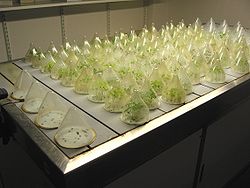Germination: Difference between revisions
No edit summary |
|||
| Line 4: | Line 4: | ||
'''Germination''' is the process whereby growth emerges from a period of dormancy. The most common example of germination is the [[sprouting]] of a [[seedling]] from a [[seed]] of an [[flowering plant|angiosperm]] or [[gymnosperm]]. However, the growth of a [[sporeling]] from a [[spore]], for example the growth of [[hypha]]e from [[Fungus|fungal]] spores, is also germination. In a more general sense, germination can imply anything expanding into greater being from a small existence or [[germ]]. |
'''Germination''' is the process whereby growth emerges from a period of dormancy. The most common example of germination is the [[sprouting]] of a [[seedling]] from a [[seed]] of an [[flowering plant|angiosperm]] or [[gymnosperm]]. However, the growth of a [[sporeling]] from a [[spore]], for example the growth of [[hypha]]e from [[Fungus|fungal]] spores, is also germination. In a more general sense, germination can imply anything expanding into greater being from a small existence or [[germ]]. |
||
GERMINATION is cool! |
|||
germintation for life! |
|||
== Pollen germination == |
== Pollen germination == |
||
Revision as of 02:05, 6 March 2008


Germination is the process whereby growth emerges from a period of dormancy. The most common example of germination is the sprouting of a seedling from a seed of an angiosperm or gymnosperm. However, the growth of a sporeling from a spore, for example the growth of hyphae from fungal spores, is also germination. In a more general sense, germination can imply anything expanding into greater being from a small existence or germ.
Pollen germination
Another germination event during the life cycle of gymnosperms and flowering plants is the germination of a pollen grain after pollination. Like seeds, pollen grains are severely dehydrated before being released to facilitate their dispersal from one plant to another. They consist of a protective coat containing several cells (up to 8 in gymnosperms, 2-3 in flowering plants). One of these cells is a tube cell. Once the pollen grain lands on the stigma of a receptive flower (or a female cone in gymnosperms), it takes up water and germinates. Pollen germination is facilitated by hydration on the stigma, as well as the structure and physiology of the stigma and style.[1] Pollen can also be induced to germinate in vitro (in a petri dish or test tube).[2][3]
During germination, the tube cell elongates into a pollen tube. In the flower, the pollen tube then grows towards the ovule where it discharges the sperm produced in the pollen grain for fertilization. The germinated pollen grain with its two sperm cells is the mature male microgametophyte of these plants.[1]
Self-incompatibility
Since most plants carry both male and female reproductive organs in their flowers, there is a high risk for self-pollination and thus inbreeding. Some plants use the control of pollen germination as a way to prevent this selfing. Germination and growth of the pollen tube involve molecular signaling between stigma and pollen. In self-incompatibility in plants, the stigma of certain plants can molecularly recognize pollen from the same plant and prevents it from germinating.[4]
Spore germination
Germination can also refer to the emergence of cells from resting spores and the growth of sporeling hyphae or thalli from spores in fungi, algae, and some plants.
Resting spores
In resting spores, germination involves cracking the thick cell wall of the dormant spore. For example, in zygomycetes the thick-walled zygosporangium cracks open and the zygospore inside gives rise to the emerging sporangiophore. In slime molds, germination refers to the emergence of amoeboid cells from the hardened spore. After cracking the spore coat, further development involves cell division, but not necessarily the development of a multicellular organism (for example in the free-living amoebas of slime molds).[1]
Zoospores
In motile zoospores, germination frequently means a lack of motility and changes in cell shape, which allow the organism to become sessile.[1]
Ferns and mosses
In plants such as bryophytes, ferns, and a few others, spores germinate into independent gametophytes. In the bryophytes (e.g. mosses and liverworts), spores germinate into protonemata, similar to fungal hyphae, from which the gametophyte grows. In ferns, the gametophytes are small, heart-shaped prothalli that can often be found underneath a spore-shedding adult plant.[1]
See also
References
- ^ a b c d e Cite error: The named reference
Ravenwas invoked but never defined (see the help page). - ^ Martin FW (1972). "In Vitro Measurement of Pollen Tube Growth Inhibition". Plant Physiol. 49 (6): 924–925. PMID 16658085.
- ^ Pfahler PL (1981). "In vitro germination characteristics of maize pollen to detect biological activity of environmental pollutants". Environ. Health Perspect. 37: 125–32. PMID 7460877.
- ^ Takayama S, Isogai A (2005). "Self-incompatibility in plants". Annu Rev Plant Biol. 56: 467–89. doi:10.1146/annurev.arplant.56.032604.144249. PMID 15862104.
External links
- Sowing Seeds A survey of seed sowing techniques.
- Seed Germination: Theory and Practice, Norman C. Deno, 139 Lenor Dr., State College PA 16801, USA. An extensive study of the germination rates of a huge variety of seeds under different experimental conditions, including temperature variation and chemical environment.
- Two methods of germinating tree seeds Learn two methods to germinate tree seeds. Either naturally or artificially.
